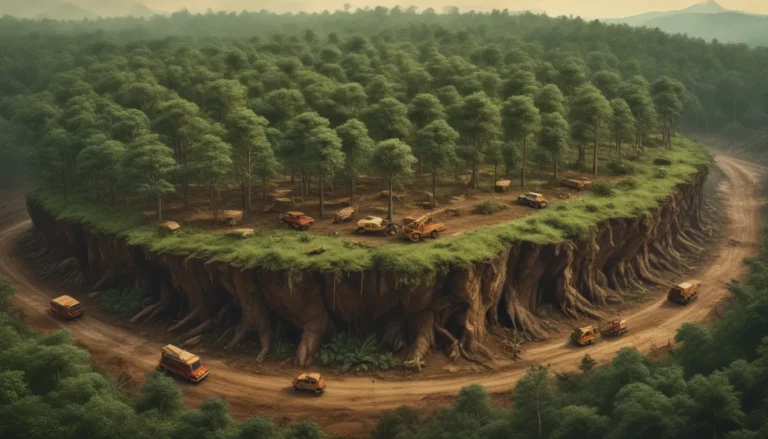A Note About Images: The images used in our articles are for illustration purposes only and may not exactly match the content. They are meant to engage readers, but the text should be relied upon for accurate information.
In today’s world, where environmental issues are at the forefront of our collective consciousness, conservation strategies have become an essential tool in preserving our planet for future generations. These strategies encompass a wide range of approaches and initiatives aimed at protecting natural resources, biodiversity, and ecosystems from degradation and depletion. From land and water conservation to wildlife management and renewable energy adoption, conservation strategies are diverse and impactful.
Exploring the Key Takeaways of Conservation Strategies
Conservation strategies are not limited to just protecting nature and wildlife; they also play a crucial role in combating climate change and involving local communities in conservation efforts. These strategies promote sustainable tourism and international cooperation for a healthier planet. By utilizing technology, promoting sustainable practices, and engaging local communities, conservation strategies not only protect biodiversity but also have positive socio-economic benefits for the communities involved.
The Role of Conservation Strategies in Preserving Natural Resources
Conservation strategies are comprehensive plans and actions designed to protect and sustainably manage our ecosystems, wildlife, forests, and water sources. By implementing these strategies, we can ensure the long-term survival and well-being of our planet. These strategies aim to strike a balance between human activities and the health of ecosystems, promoting a harmonious coexistence between nature and society.
The Impact of Technology on Conservation Efforts
Innovative technologies such as satellite imaging, drones, and wildlife monitoring systems have revolutionized conservation efforts. These tools enable scientists and conservationists to gather critical data, track wildlife populations, and identify areas in need of protection more efficiently and effectively. Technology has become a powerful ally in the fight to preserve our planet’s natural resources and biodiversity.
Combating Climate Change Through Conservation
Integrating sustainable practices in agriculture, energy production, and transportation is crucial for mitigating climate change. Conservation strategies promote the use of renewable energy, reforestation, and carbon capture technologies to reduce greenhouse gas emissions and their impact on the environment. By addressing climate change, conservation strategies play a vital role in safeguarding the future of our planet.
The Importance of Community Involvement in Conservation Efforts
Engaging local communities in conservation initiatives is essential for the long-term success of conservation strategies. By involving communities in decision-making processes, providing education and incentives, and recognizing their traditional knowledge, conservation efforts can build partnerships and create a sense of stewardship for the environment. Community involvement is key to ensuring the sustainability of conservation initiatives.
Protecting Biodiversity and Endangered Species
Conservation strategies aim to protect biodiversity and endangered species by conserving and restoring natural habitats, implementing regulations against illegal wildlife trade, and supporting wildlife sanctuaries and protected areas. By safeguarding biodiversity, conservation efforts contribute to the preservation of ecosystems and the survival of vulnerable species on our planet.
Promoting Sustainable Tourism Through Conservation Strategies
Sustainable tourism practices are an integral part of conservation strategies, promoting responsible travel and minimizing the negative impact of tourism on the environment. By limiting visitor numbers, promoting responsible wildlife viewing, and reducing waste and pollution, conservation strategies ensure that natural destinations are preserved for future generations to enjoy. Sustainable tourism goes hand in hand with environmental conservation.
The Need for International Cooperation in Conservation
Conserving our global natural heritage requires collaboration and cooperation between nations. International agreements, such as the Convention on Biological Diversity and the Paris Agreement, provide frameworks for countries to work together and share knowledge, resources, and expertise in conservation efforts. International cooperation is essential for addressing environmental challenges on a global scale.
Emphasizing the Sustainable Use of Natural Resources
Conservation is not just about preservation; it also focuses on the sustainable utilization of natural resources. By implementing sustainable forestry practices, promoting responsible fishing methods, and supporting renewable energy alternatives, conservation strategies ensure that resources are used in a way that balances human needs with environmental protection. Sustainable resource management is a core component of conservation efforts.
The Positive Socio-Economic Benefits of Conservation
Conservation efforts can have positive socio-economic benefits by creating jobs in eco-tourism, sustainable agriculture, and natural resource management. Additionally, protecting natural areas can enhance the well-being of local communities by providing clean water, regulating climate patterns, and preserving cultural and historical landmarks. Conservation strategies not only benefit the environment but also contribute to the livelihoods and prosperity of communities involved.
Conclusion: Upholding the Values of Conservation Strategies
In conclusion, conservation strategies are vital for ensuring the sustainability and preservation of our natural resources and environment. From habitat restoration to sustainable farming practices, these strategies address various challenges and aim to protect biodiversity, mitigate climate change, and promote responsible land and water management. By adopting innovative approaches and working collaboratively, conservation efforts can make a significant impact in safeguarding our planet for future generations. It is essential for individuals, communities, and governments to prioritize and support these strategies, as they are fundamental to the well-being of both humans and the diverse species we share this planet with.
Frequently Asked Questions
- What are some common conservation strategies?
- Protected area management
- Species reintroduction
- Sustainable resource use
- Habitat restoration
-
Public education and awareness programs
-
How do conservation strategies help the environment?
- Preserve natural habitats
- Protect endangered species
- Promote sustainable practices
-
Mitigate negative impacts of human activities
-
What are the benefits of implementing conservation strategies?
- Maintain biodiversity
- Safeguard ecosystem services
- Mitigate climate change
- Promote sustainable development
-
Enhance resilience to natural disasters
-
How can individuals contribute to conservation efforts?
- Reduce carbon footprint
- Practice sustainable consumption
- Support conservation organizations
- Volunteer
-
Advocate for environmental protection policies
-
Are conservation strategies effective in preserving endangered species?
- Yes, through efforts such as captive breeding programs and habitat restoration, many endangered species have been saved from extinction.
Our commitment to delivering trustworthy and engaging content is rooted in our dedication to providing accurate and credible information. Each fact on our site is contributed by real users, ensuring a wealth of diverse insights and knowledge. Our editors meticulously review each submission to guarantee the highest standards of accuracy and reliability. Trust in our commitment to quality and authenticity as you explore and learn about the fascinating world of conservation strategies.






